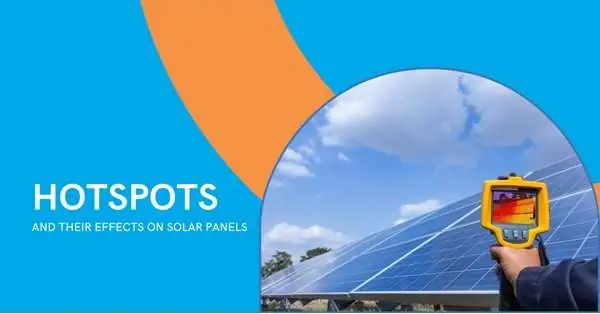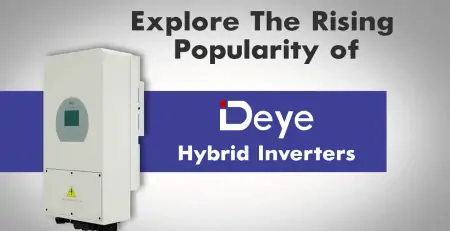Hotspots And Their Impacts On Solar Panels
powernsun2023-11-14T18:24:43+04:00Solar energy promises a sustainable and independent energy generation world. As the number of people relying on solar energy to become self-reliant in energy production is increasing, it is good to be aware of the potential issues that may impact the performance and power output of solar panels.
No doubt that solar panels are the best investment in the long run. Still, you should understand the crucial concept of hotspots and how they affect solar panels.
What are hotspots?
Hotspots on the solar panels indicate areas where there are possibilities to generate excessive heat. Typically, these areas are often subject to high temperatures when compared with other parts of the panels. This problem can occur when the energy generation of the solar panel is disrupted, say for example: shading issues. If the energy of the solar panel becomes unable to flow through the inverter, it gets overloaded, resulting in excessive heat and they become ‘hot’.

These hotspots are common occurrences with solar panels, yet, they are difficult to predict. If the panels get heated and overloaded, it will lead to a short-circuit; ending up with reduced overall panel output efficiency and increasing the chances for material degradation.
To put it simply, a hotspot on solar panels is a reliability problem with panels in which a mismatched cell heats up extensively and degrades the power performance of the panels.
Formation of Hotspots – What are the causes?
The formation of hotspots on solar panels can happen for several reasons. This includes:
Projected shadows – When an object closer to or above the solar panels creates shadows on the solar panels, such as buildings, walls, trees, etc results in projected shadows on the panels, leading to hotspots.
Mechanical damage – this covers damages such as broken/bent frames, improper fixing of the modules, broken glass, and collisions of modules with each other or with other objects.
Soiling – This serves as one of the major causes for the formation of hotspots. Dirt, deposits, and bird droppings that are accumulated on the surface of the solar panels prevent the sunlight from entering the solar cells at certain points. This blocking becomes the cause for the creation of hotspots in the panels.
Structural damage/ internal module failures – common cell material defects such as cell cracks, poor solder joints, defective cell arrangement, lamination problems, and local delamination can also pave the possibilities for hotspots.
Effects Of A Hotspot On A Solar Panel
If a hotspot is created on the PV module, the related impacts probably depend on the duration of it. In general, hotspots are unstable and they eventually intensify till they reach a point where the overall performance of the solar panel is affected.
If the duration of the hotspots is longer, the huge damage it will cause to the solar panels.

- As the solar cells are connected in series, hotspots can cause considerable impact on the neighboring cells and also on the whole solar cell.
- Affects the total power generation of the solar panels
- In worst cases, hotspots can lead to the collapse of the panels
- Makes the protective glass crack, leading to moisture entry in the cell, and leading to system failure.
- Apart from affecting the performance of the panels, these hotspots can also create permanent damage to the cells.
- Can also lead to issues such as glass breaking, degradation of the solar cell, melting of the sheets underneath the panels, and in extreme cases, it can lead to fire
- This leads to costly repairs and replacement
How To Avoid Hotspots On Solar Panels – Ways To Save Your Solar System
Hotspots can occur anytime on the solar panels during their lifetime. The sad thing is these hotspots are not visible to the naked eye. Only if there is an obvious color difference, eg. A brownish spot, you can identify the issue. However, by taking certain measures you can avoid the problem. Here are some of the tips provided that will help you in preventing the formation of hotspots.
- Maintain adequate airflow – As hotspots are the result of heat builds up in the cell, by maintaining sufficient airflow in the solar system, you can avoid the formation of them. It is always recommended by experts to ensure good ventilation in the solar setup to avoid the panels getting overheated.
- Daily precautions – Make sure that there are no foreign objects such as bird droppings, and weeds near the panels. Also, try to locate any obstacles that may project shadows on the panel such as plants, water tanks, trees, electricity wires, Regularly clean the panels to avoid low temperatures and freezing in winter.
- Regular maintenance – Dirt, dust, and debris on the panels not only reduce the potential of producing power of the panels. But it also causes hotspots. Hence the solar system should have its regular maintenance activities to keep it clean and clear.
- Consider a solar tracking system – In contrast to conventional solar systems where the panels are in the same position, systems with solar tracking enable the panels to move based on the direction of the sun. As solar tracking systems help in exposing the panels to direct sunlight, your solar system is safeguarded against the formation of hotspots.
Choose the right solar panels
One of the highly recommended countermeasures for avoiding the hotspots is to choose high-quality and tier 1 solar panels such as Longi, JA Solar, and Trina. Since these solar panels are assured of their top-notch quality, you can drastically reduce the possibilities for these dreadful hotspot issues. Spend enough time to find the right solar panel distributor who can address your specific requirements with top-notch quality panels. Quality solar panels will come with integrated hotspot management features such as bypass diodes and also they are designed to tackle conditions such as soiling or shading.
Get The Right Quality Solar Panels For Your Needs
If you are considering solar panels for your energy project, Powernsun is your one-stop solution. We are committed to supplying the best quality solar panels and other productions for photovoltaic power generation systems worldwide.











